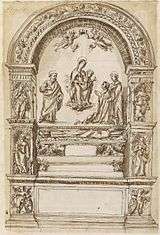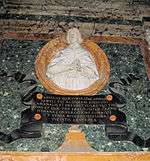Cybo Chapel (Santa Maria del Popolo)

The Cybo Chapel (Italian: Cappella Cybo) is the second side chapel in the right-hand aisle of the Basilica of Santa Maria del Popolo in Rome. For the beauty of its paintings, the preciousness of marble revetments covering its walls and the importance of the artists involved in its construction the chapel is regarded one of the most significant sacral monuments erected in Rome in the last quarter of the 17th century.[1]
History
The previous chapel on this site was erected by Cardinal Lorenzo Cybo de Mari, nephew of Pope Innocent VIII, and dedicated to St Lawrence. Giorgio Vasari claimed that the patron was Cardinal Innocenzo Cybo but the dedication over the altar recorded the actual patron. Lorenzo Cybo de Mari was promoted to the cardinalate in 1489. The chapel was constructed during the time between his elevation and his death in 1503.[2] Its architecture was identical to those of the left and right: the Chapel of the Nativity and the Basso Della Rovere Chapel. It was decorated with frescos by Pinturicchio and works by the school of Andrea Bregno which were lost during the later rebuilding. The old fresco of the Virgin and the Child by Pinturicchio was detached from the wall and sent by the cardinal to Massa in 1687. The fragment was re-used as the altarpiece of the Ducal Chapel of the Cathedral of Massa.[3] The very fine funeral monument of Lorenzo Cybo de Mari was transferred to the church of San Cosimato where its fragments are still preserved. It is attributed to Andrea Bregno and Giovanni Cristoforo Romano and was made between 1503 and 1510.
Construction works of the new chapel, which replaced the former one began in 1682 and ended five years later. The chapel was consecrated on 19 May 1687. The chapel was built by Cardinal Alderano Cybo (1613-1700) to glorify the achievements of his family, the dukes of Massa and princes of Carrara. The entrance arch of the chapel was decorated by the ducal arms of the Cybo Malaspina dynasty made of polychrome marble.[1]
Description

The large chapel was constructed by Carlo Fontana in the form of a Greek cross. The barrel-vaulted vestibule is enclosed by a black marble balustrade. The chapel itself is surmounted by a dome which is crowned by a lantern and a tiny cupola. From the outside the dome is a prominent landmark on Piazza del Popolo.
Inside the walls are covered by rich polychrome revetments in black marble and green verde antico. The eight columns flanking the pillars at the corners are yellow, red veined Sicilian jasper with white marble capitals. The colour scheme is rather dark creating a brooding atmosphere.
The huge altarpiece is one of the most important works of Carlo Maratta, finished in 1686. It depicts the Disputation over the Immaculate Conception with the Four Doctors of the Church, St Augustine, John Chrysostom, John the Evangelist and Gregory the Great celebrating the purity of the Virgin. The composition is reminiscent of Raphael’s, and the details are rendered with an extreme precision and a particularly felicitous touch.[1] The small coffin below the altar contains the relics of St Faustina.
The swirling fresco of the dome was executed by Luigi Garzi in 1684 and depicts The eternal Father in glory among angels. On the side walls are the tombs of Cardinal Alderano and Lorenzo Cybo with marble busts sculpted by Francesco Cavallini. The two bronze putti holding up the main altar are also his works. There are two paintings on the side walls of the vestibule by Daniel Seyter, the Martyrdom of St Catherine of Alexandria (1685) and the Martyrdom of St Lawrence.
Gallery
- View of the chapel from the nave
 Carlo Maratta:Disputation over the Immaculate Conception
Carlo Maratta:Disputation over the Immaculate Conception Dome fresco by Luigi Garzi: The eternal Father in glory among angels
Dome fresco by Luigi Garzi: The eternal Father in glory among angels- The marble decoration is exceptionally rich and colourful
- Side wall (left)
 Tomb of Alderano Cybo by Francesco Cavallini
Tomb of Alderano Cybo by Francesco Cavallini- The dome of the chapel is a prominent landmark on Piazza del Popolo
Notes
- 1 2 3 Federici, cit., pag. 49.
- ↑ Passaglia Bauman, cit., pag. 56.
- ↑ Federici (2003), cit., pag. 344-45, 350.
Bibliography
- Fabrizio Federici, Tre pittori per un dipinto: L’interno della Cappella Cybo del Museo di Roma, in: Bollettino dei Musei Comunali di Roma, n. s. XVI (2002), p. 49
- Fabrizio Federici, La diffusione della “prattica romana”: il cardinale Alderano Cybo e le chiese di Massa (1640-1700), in: Atti e Memorie della Deputazione di Storia Patria per le antiche Provincie Modenesi, s. XI - v. XXV, 2003, pp. 315–389.
- Lisa Passaglia Bauman, Piety and Public Consumption: Domenico, Girolamo and Julius II della Rovere at Santa Maria del Popolo; in: Patronage and Dynasty. The Rise of the Della Rovere in Renaissance Italy, Truman State University Press, 2007
| Wikimedia Commons has media related to Santa Maria del Popolo (Rome). |